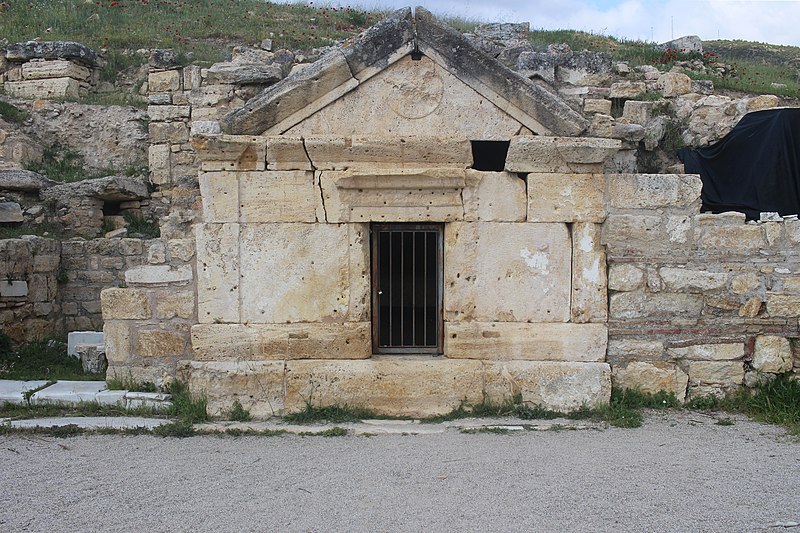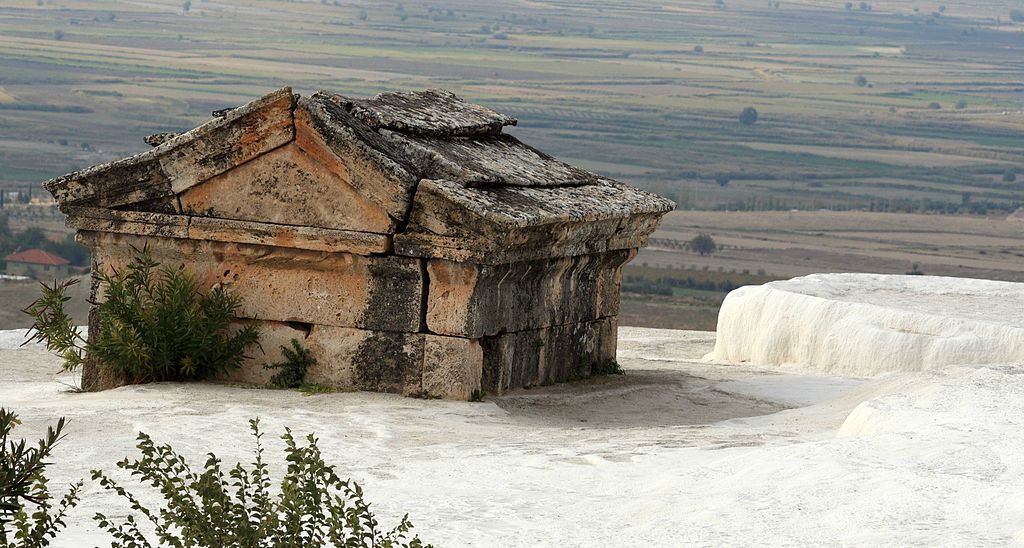Travairtín Pools of Qalˈqat
The Travairtín Pools of Qalˈqat (/kɑːl ˈkɑːt/) are a spectacular array of natural rimstone pools formed behind a series of terraced travairtín dams below the abandoned ancient city of Nabeshif in western Nemed. Located just north of the town of Qalˈqat, the striking natural feature was formed over the course of millennia as the warm, mineral-rich waters of nearby thermal springs poured over the hillside, leaving behind deposits of carbónáit minerals which in time formed the dramatic white stone landscape.
The place has been a spiritual, cultural, and recreational destination for thousands of years, celebrated as a natural wonder since the 6th centurí BCS, when the city of Haksemset was built to take advantage of the effervescent healing waters of the hot springs, which flow at temperatures between 95° and 212° on the Feinheit scale. Since 1966, the site has been listed as a C.N. World Heritage Site.
Etymology
The town name of Qalˈqat is a descriptor of its location. It is derived from the Nemidic terms ϙαλεατ (qaleat, “palace, castle”) + αλϙατν (alqatn, “cotton”), meaning “cotton castle” or “cotton palace,” an allusion to the large outcropping of white travairtín nearby.The name of the ruined city, Nabeshif, is derived from Nemidic ύαναβιε (yanabie, “springs”) + λιλσηιφα (lilshifa, “to heal”), meaning “healing springs.”
The original name of Haksemset (Ηκησμτ) is of unknown origin, but believed to be related to Aigúpiti Ηκη (hakh, “temple”), perhaps “temple of Semset,” a forgotten god.
Description
The travairtín deposits at Qalˈqat are the largest in the world, averaging over 50 yds deep and covering an area of over 2.7 wmi2. Their brilliant, pure white color stands out dramatically from the surrounding countryside, and they can be seen with the naked eye from as far away as Uqamim. The turquoise mineral-rich waters of its shallow, scallop-shaped pools contrast sharply against the brilliant white travairtín of their surroundings, as they cascade 200 yds down the cliffs below the ruins of Nabeshif.The extensive remains of the ancient city of Nabeshif sit atop the cliff to the north, while the “new” town of Qalˈqat has grown up below the hillside to the south. The ruins of Nabeshif include the main street bordered on both sides by an arcade with imposing gates at both ends, as well as a triumphal arch flanked by two circular towers near the north gate. There is also a large, well preserved theater, several plundered temples, baths, and an extensive necropolis, upon which the travairtín has been encroaching for several centurís.
History
Travairtín deposits have been taking place at the site for at least 600,000 years since the Pleistocéin epoch, with the majority of the deposition occurring in the past 50,000 years. Research suggests new travairtín production has increasingly accelerated since a devastating quake struck the area in the 7th centurí CA.In the first half of the 7th centurí BCS, the Qubti built a temple above the travairtín pools, on the site of a previous Aigúpiti temple that had been reduced to ruins for more than 1000 years.1 The Qubti temple would later become the center of the city of Haksemset. Founded as a thermal spa in the 6th centurí BCS, the city grew rapidly. The walls were expanded in 390 BCS with booty from the Battle of Kaaz Nasim.
The walls of Haksemset were no match, though, for the Sukaan raiders from the north, who began their conquest of the Jeneb in the early 4th centurí BCS. The city fell to the Sukaan, aided by the treachery of the Shufani-Qubti, in 305 BCS. Renamed Nabashif, the city flourished under Sukaan rule, as thousands of people came to benefit from the healing properties of the warm bubbling waters. By 100 BCS over 72,000 people lived and worked in Nabashif.
In the first centurí CA, Saint Feidhlim, an Early Father of the Sanctist faith, sailed across the Torrean Sea with his wife, Muireamnín, and her brother, Saint Beartla, to preach the Two Principles among the Sukaan of Janubia. Through miraculous healings and persuasive preaching, Feidhlim succeeded in converting the wife of the ˈAmir of Nabeshif. The enraged ˈAmir had Feidhlim, Muireamnín and Beartla tortured, before Feidhlim was martyred by beheading in 80 CA.
According to one account, Feidhlim’s severed head continued to preach the Two Principles for seven days after he was executed, causing all who heard him to convert to Sanctism on the spot. The city was “pacified” by the ˈAmir several years later, and its Sanctist population sold into slavery. Saint Feidhlim’s tomb is said to be among the ruins of the city visible even today.
A major quake in 230 CA destroyed part of the city, which was eventually rebuilt. Another quake in 553 CA left the city in ruins. It was rebuilt once again, this time in the Nemedian style, with financial assistance from ˈAmir Umar I. Another severe quake in the 7th centurí caused major destruction across the city, but the city was rebuilt yet again and renamed Nabashif Qiama (“resurrected”). This is the city we see in ruins today.2
The great alchemist Abdul Gumud of Chaam is said to have visited Nabashif in the early 9th centurí and bathed in the warm mineral pools. One account describes his visit to the original temple in the center of the city, where he pressed his ear against the stones, listening for the wisdom of the ancient people who came before the Aigúpiti. He also visited the tomb of Saint Feidhlim, and went inside, where he performed incantations.
Recent Developments
Many western soldiers were exposed to the lands of the east during the Great Intercontinental War (1908 - 1915) and brought back home with them stories and descriptions of exotic customs, strange places and unfamiliar sights like those in Qalˈqat. This led to an increased interest in all things eastern that took hold in the western consciousness from the time the war ended. Popular interest in eastern cultures reached its peak in the 1940s, and tourist travel to eastern destinations was all the rage.
While the healing pools of Qalˈqat had been a popular local and regional destination for hundreds, if not thousands of years, in the twentieth centurí the area also became a popular place for western travelers to visit. By 1950 the daily influx of high volumes of visitors seeking to take in the healing waters was overtaxing the resources, and threatened to cause real damage to the landscape.
As a result, the government of Nemed took action in 1954 to bring order to the chaos, and protect the ancient natural beauty of the site. A portion of the warm healing waters was diverted from the pools and conducted by a pipeline to a newly constructed public bathing area, large enough to accommodate the swelling crowds of tourists. Well-marked foot paths were constructed, which allowed visitors to view the tremendous natural beauty of the travairtín formations without causing irreparable damage. And a paved road was built to transport tourists by motor coach up the hill to visit the ancient ruins, reducing motorcar traffic in the area.
These new measures, although limiting the visitor experience somewhat, have gone a long way to preserving this delicate natural wonder and cultural icon for future generations.
While the healing pools of Qalˈqat had been a popular local and regional destination for hundreds, if not thousands of years, in the twentieth centurí the area also became a popular place for western travelers to visit. By 1950 the daily influx of high volumes of visitors seeking to take in the healing waters was overtaxing the resources, and threatened to cause real damage to the landscape.
As a result, the government of Nemed took action in 1954 to bring order to the chaos, and protect the ancient natural beauty of the site. A portion of the warm healing waters was diverted from the pools and conducted by a pipeline to a newly constructed public bathing area, large enough to accommodate the swelling crowds of tourists. Well-marked foot paths were constructed, which allowed visitors to view the tremendous natural beauty of the travairtín formations without causing irreparable damage. And a paved road was built to transport tourists by motor coach up the hill to visit the ancient ruins, reducing motorcar traffic in the area.
These new measures, although limiting the visitor experience somewhat, have gone a long way to preserving this delicate natural wonder and cultural icon for future generations.
1 According to Desmond Hynes, Professor of Eastern Antiquities at the University of Naus, the Aigúpiti temple was itself built upon the ruins of an even earlier temple of unknown origin.
2 After the 7th centurí, the city entered a slow period of decline. It was finally abandoned in the 13th centurí, with most of its remaining population relocating to nearby Haidamiya.





This is very, very, very well done - like, this reads like it should be a proper Wikipedia article. You've even used superscripts to do references - wow! (though, er, maybe check the codex page and link these using anchors?) I could talk for a long while on the detail you've put into this history, but I already spent a while talking about how much I liked it over in the reading challenge. What I'd like to ask instead is, what's its current situation? It's a heritage site and it's celebrated for a number of traditions, but there's not much on who currently visits it!
welcome to my signature! check out istralar!
I am truly grateful and humbled by your kind words. Thank you for taking the time to read my article. Your suggestions were very constructive. I'm still trying to figure out how to make the anchor function line up the way I want, but I threw in a tooltip at the footnote so you can pop it up as you are reading, and that seems to work ok. I also added a final section that addresses the current situation at the pools, and it really improves how the article ends. Thanks again!!
I just want to check, since I don't think I've seen you in the Discord - are you aware of the Reading Challenge? I did give some further comments on your work there. ^^
welcome to my signature! check out istralar!
Yes! I did not participate, but I went to your article and was guided to a slew of really excellent Summer Camp entries. I still cannot believe you included my article among them. Your kindness has inspired me to learn a little more BBCode, and I even joined the Discord the other day for the first time (still learning my way around). A kind word really can go a long way. Heartfelt thanks!
Aw! I'm glad I've led you to a few lovely places, and that you've found the opportunity to learn even more too! WA's a constant journey, isn't it? If you're ever confused in the Discord, feel free to ping me - I'm one of the mods in there, so I'm happy to give some guidance, haha.
welcome to my signature! check out istralar!